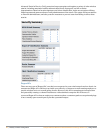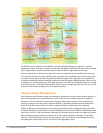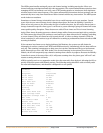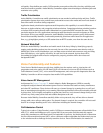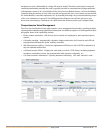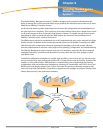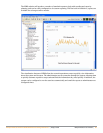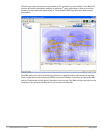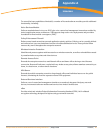
60 | Voice over Wi-Fi Campus Wireless Networks Validated Reference Design Version 3.3 | Design Guide
call quality. Jitter buffers are used in VoIP networks to smooth out this effect, but they add delay and
must be as small as possible. Aruba Mobility Controllers adjust network settings to minimize jitter and
maximize voice quality.
Traffic Prioritization
Aruba Mobility Controllers use traffic prioritization as one method to address delay and jitter. Traffic
prioritization assures that voice packets have preferential access to the media and are moved ahead of
best-effort traffic in buffers during congestion.
Application-based prioritization requires stateful inspection; this capability is a crucial difference
between an Aruba solution, and competing wireless solutions. Competing solutions prioritize based on
a wireless SSID, meaning that all traffic transmitted on a particular SSID is treated the same. This
precludes support for voice applications running on multi-function devices such as laptops or PDAs,
since these devices use multiple protocols. Aruba Mobility Controllers contain a policy enforcement
firewall that statefully identifies, tracks and dynamically prioritizes traffic based on the application
flow, e.g., giving higher priority to a SIP session than an HTTP session, even from the same device.
Network Wide QoS
While the Aruba Mobility Controllers can handle much of the heavy lifting by identifying, properly
tagging, and scheduling packets into the network, the rest of the components must also be ready to
handle QoS. If the access, distribution, core, and data center switches and routers are only providing
best effort delivery, voice quality will suffer. At each level in the network, devices that will be
forwarding QoS tagged traffic must be configured to properly prioritize traffic above data and
background traffic.
Voice Functionality and Features
Voice Service Module features provide deep visibility into the session, such as, viewing the call
progression and voice quality of a SIP based VoIP call. Advanced voice-over-WLAN features such as
Call Admission Control (CAC), voice-aware RF management, and voice-specific diagnostics allow the
Mobility Controller to deliver enterprise class mobile VoIP capabilities.
Voice-Aware RF Management
As discussed in Chapter 7 on page 55, Aruba’s Adaptive Radio Management (ARM) is normally
configured to adjust channel and transmit power levels of wireless APs based on nearby interference
and other RF conditions. Client devices will react to a channel change by scanning for a new AP and
then re-associating as though they were roaming. Most data applications will not be noticeably affected
by this action. Voice is highly susceptible to packet loss, however, and a channel change during a voice
call will very likely cause packet loss and audible disruption to the call.
Because Aruba Mobility Controllers statefully follow voice protocols, they will not allow a channel
change while voice calls are taking place. If a channel change is required, the controller will wait until
that AP is no longer handling active voice calls before initiating the channel change.
Call Admission Control
Typical voice codecs (Coder/Decoder) used in VoIP do not consume large amounts of bandwidth. Even
with G.711, which uses 64Kbps per call, a typical 802.11b access point could theoretically support
nearly fifty simultaneous calls based purely on bandwidth. In practice, the limiting factor is contention
for the wireless medium because 802.11 uses a collision-avoidance algorithm that makes timely access
to the wireless media a challenge for delay-sensitive devices. Due to this limitation, the number of



